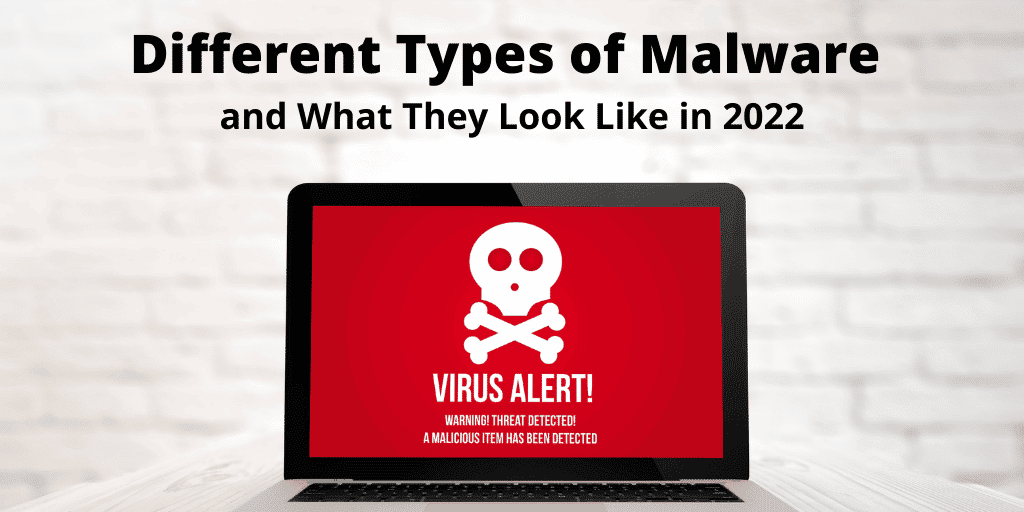As one of the most common cyberattack methods, malware, in all of its forms, has caused lasting damage to millions of victims across the globe. One of the best ways to minimize the risk of a malware attack is to recognize it for what it is before you interact with it.
Here are the different forms of malware you can come across in 2022.
Types of Malware
Fileless Malware
Fileless malware is a sneaky form of malware that uses legitimate programs and tools to infect a computer. This form of malware is tough to detect because hackers don’t need to install any code in a victim’s system. Victims interact with a trusted, recognizable platform that seems safe and is unknowingly targeted by powerful malware. Common targets of fileless malware are PowerShell and Windows Management Instrumentations (WMI). Because of their trustworthy reputations, analysts are slower to realize that they are functioning maliciously.
What fileless malware looks like in 2022
Advanced fileless malware technology in 2022 is particularly tricky to detect — even by anti-malware software. Hackers have learned to target the most trusted platforms that many teams don’t deem as suspicious, and execute the cyberattack within the computer’s Random Access Memory, which allows it to leave little to no trace after execution. That’s why investing in quality continuous monitoring and malware detection is crucial to identify and combat the consequences of fileless malware.
Spyware
Spyware is a form of malware that allows hackers to access and obtain sensitive or valuable information from individuals or businesses. Spyware can hijack website activity, search activity, turn on webcams, take screenshots and more. Hackers can then use the information for blackmail, selling information and looking into people’s personal lives.
What does spyware look like in 2022?
Government officials, big business CEOs, and people of note are increasingly concerned about spyware on work computers and personal devices. Monetizing government and high-security secrets is a common goal for hackers worldwide, but it’s not just people of note that need to protect themselves against spyware. Anyone can become a victim and deal with spyware’s costly and dehumanizing outcome.

Ransomware
Ransomware is a nasty form of malware that infects a computer and restricts user access to their information until they pay a ransom. Ransomware is an incredibly effective cyberattack. According to Security Magazine, in 2021, 83% of ransomware victims ended up paying the ransom.
What ransomware looks like in 2022
It’s no secret to hackers how successful ransomware can be — so some are cashing in by selling ransomware “kits” (ransomware as a service) far and wide. Unfortunately, that makes ransomware technology more obtainable than ever.
Adware
No, you did not just win an all-expenses-paid trip to the Bahamas. Adware is a particularly annoying form of malware that usually boasts about winning a contest, a huge sale and other obnoxious “click me” tactics. This generates revenue for the hacker through online ads presented to the victim during the installation process.
What does adware look like in 2022?
In 2022, AdWare alone accounts for 48% of all malware. When adware started, it looked cheesy and obviously sketchy. And while some adware still seems obvious, some modern adware is much more native and sleek. As a result, it can be easier to be fooled and fall victim to unwanted software downloading and negatively impacting your computer.

Trojan
Coined from the famous Roman mythology anecdote about the Trojan Horse, a Trojan virus follows the same strategy as its namesake. Trojan viruses are disguised as operational benign or helpful programs but are actually decoys used to hijack your computer.
What does a Trojan virus look like in 2022?
Fifty-three percent of malware uses the “Trojan Horse” Strategy of penetrating systems. Trojan viruses in 2022 have shed their easily identifiable and quickly-recognizable facades for much more convincing fronts. Many more advanced viruses need a suspicious eye to identify the actual program from the fake. They are easily spread through effective phishing scams and can be used to access banking login credentials and other valuable data.
Worms
The longer that a worm lives on your computer, the harder it can be to slow down the negative impacts of this form of malware. The nature of the worm virus is to get into your computer and replicate as many times as possible. Once it’s unleashed, it will jump from computer to computer, finding as many victims as possible before it is detected and controlled.
What does a worm look like in 2022?
Worm viruses are becoming more complex and harder to contain — which makes it that much more important to protect yourself from worms in the first place. While the most powerful worm attack happened back in 2004 (MyDoom caused 52 billion dollars worth of damage across the globe), that doesn’t mean there isn’t the risk of a powerful worm virus in 2022.
Virus
A virus is like a back door into a computer that can introduce a host of malicious activity. A virus is a rogue piece of code that inserts itself into an otherwise clean application. When the application runs, so will the virus. Once activated, it can launch DDoS attacks, steal essential or valuable data and conduct ransomware attacks.
What does a virus look like in 2022?
2022 shows malware blurring the lines between forms, including viruses. A virus can act as ransomware, a worm or other forms of malware to cause even more issues for victims. The one weakness of viruses is they are only active when the platform they connect to is active.

Rootkits
Rootkits are a significantly dramatic and exasperating form of malware because the human-like activity that it uses can fool behavioral analysis software. Rootkits conduct a cyberattack by granting hackers control over a victim’s computer with full admin access. The malware will execute human-like actions of opening browsers, clicking links and downloading files. From here, hackers can conduct ad click fraud to make money.
What does a Rootkit look like in 2022?
Modern rootkits are incredibly complex — they can neutralize other active malware, fool simple cybersecurity precautions and spread through common phishing scams. Rootkits can even be used in tandem with other dangerous forms of malware to strengthen the attack.
Keyloggers
Keyloggers can be used for good. For example, companies can add this technology to work computers to monitor and track employee activity or reduce inappropriate web searches. It can also be helpful technology for families to monitor the content that children find on the web. But this technology can also be used for evil by hackers to steal passwords and spy on computer activity.
What does a keylogger look like in 2022?
Keyloggers are not the most sophisticated malware, but they are most accessible in 2022. Hackers can buy simple keylogger technology on the black market for as little as $25.
Bots/Botnets
Bots and botnets are another technology used with good and bad intentions. A bot is an application that helps with the automation of online activities. When used as a virus, bots can penetrate deep into a computer and connect back to a central server. Once the virus turns the central server into the “mothership” for the botnet, it can create a network of compromised computers and devices. This virus can replicate itself and make millions of victims as it grows.
What does a bot look like in 2022?
Bots are very sophisticated in the widespread damage they can cause. With their ability to replicate and transfer from computer to computer, a strong bot can be tough to control and costly to mitigate.
Mobile Malware
Mobile malware is a newer form of malware developed with the insurgence of smartphones. Mobile malware can cause the same damage that trojans, ransomware, and spyware are easily distributed through phishing scams and malicious downloads.
What does mobile malware look like in 2022?
Mobile malware has been on a dramatic incline recently, especially with jailbroken phones. Phones that relinquish the default protections against malware are much more susceptible to cyberattacks by mobile malware.
MDL Technology can help!
Being the victim of a malware attack is taxing, frustrating and costly. Since most cyberattacks result from human error, the more you and your team understand anti-malware strategies, the less susceptible you will be to attacks.
At MDL, it’s our job to train your employees on the best practices to keep data safe from potential hackers. We’re experts in providing a proactive approach to cybersecurity for your business. From training to continuous monitoring to cybersecurity, your data is safe and secure with MDL Technology.







